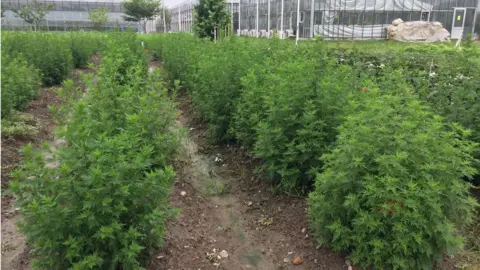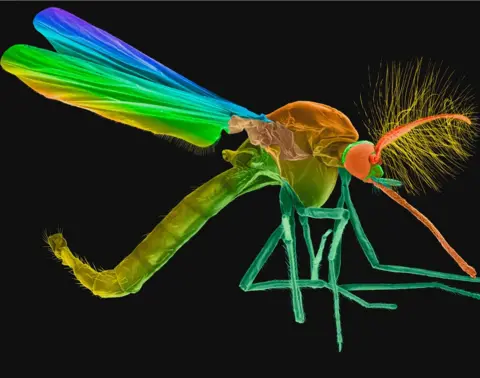GM plant tech boosts malaria drug yield
 Ying Liu / Xinhua
Ying Liu / XinhuaScientists have modified a plant's genetic sequence to make it produce high levels of a key malaria drug, potentially helping meet the large global demand.
The team identified genes involved in making artemisinin, altering their activity to produce three times more of the drug than "normal" plants make.
The plant-based production of the drug sometimes fails to meet demand.
The shrubs don't produce enough of the chemical in their leaves.
"Nearly half of the world's population is at risk of malaria," said co-author Kexuan Tang of Shanghai Jiao Tong University.
"Our strategy for the large-scale production of artemisinin will meet the increasing demand for this medicinal compound and help address this global health problem."
The team produced a high quality draft of the Artemisia annua plant's genome and used this information, along with data on how genes are expressed, to engineer plants that produced high levels of artemisinin.
The World Health Organization (WHO) says malaria affected about 216 million people in 91 countries in 2016, and caused an estimated 445,000 deaths worldwide that year alone.
"Artemisia annua remains the sole source of the World Health Organization recommended treatment for malaria, which continues to be a devastating disease in the developing world," said Prof Ian Graham from the University of York, who was not involved with the study.
Field trials
The A. annua genome contains 63,226 protein-coding genes, one of the largest numbers among any known plant species. It took the team several years to complete the sequence, due to its size and complexity.
Previous efforts to increase the yield of artemisinin had been hampered by the absence of a reference genome and the limited information about the genes involved in regulating the drug's synthesis.
But by simultaneously increasing the activity of three genes - HMGR, FPS, and DBR2 - the researchers generated A. annua lines that produced high artemisinin levels - about 3.2% of the dry weight of the leaves.
The compound typically makes up only 0.1%-1.0% of the dry weight of non-engineered A. annua leaves.
 SPL
SPLCommenting on the study, Prof Graham told BBC News: "This is quite an achievement, building as it does on earlier molecular breeding and genetic engineering attempts.
"Before the work could have an impact on commercial production it will require extensive field trials to demonstrate that the engineered plants perform in the field as well as they have done under experimental conditions."
Indeed, Dr Tang and his team have sent artemisinin-rich seed samples to Madagascar, the African country that grows the most A. annua, for a field trial. The researchers are also continuing to explore ways to enhance artemisinin production, with the goal of developing versions whose leaves contain 5% artemisinin.
"We hope our research can enhance the global supply of artemisinin and lower the price from the plant source," Dr Tang said.
"It is not expensive to generate high-level artemisinin lines. We have propagated hundreds of high artemisinin producer lines via cutting and selection, and scaled up the production of these plants.
"Hopefully our high artemisinin transgenic lines will be grown at a massive scale next year."
But the engineered shrub would still have to clear the hurdle of approval. Ian Graham said: "Most importantly, commercialisation will also require GM approval prior to release of engineered plants to be grown outdoors in China or elsewhere in the world.
"According to the International Service for Acquisition of Agri-Biotech Applications, there are currently no GM A. annua approved anywhere in the world, and this will be an interesting challenge to gain approval, particularly in China where the A. annua crop is grown and where the plant is a high profile example of Chinese Traditional Medicine."
Follow Paul on Twitter.
